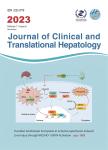The Discovery and Development of Boceprevir:A Novel, First-generation Inhibitor of the Hepatitis C Virus NS3/4A Serine Protease
The Discovery and Development of Boceprevir:A Novel, First-generation Inhibitor of the Hepatitis C Virus NS3/4A Serine Protease作者机构:Merck Sharp & Dohme Corp. Whitehouse Station NJ USA
出 版 物:《Journal of Clinical and Translational Hepatology》 (临床与转化肝病杂志(英文版))
年 卷 期:2013年第1卷第1期
页 面:22-32页
学科分类:1004[医学-公共卫生与预防医学(可授医学、理学学位)] 1002[医学-临床医学] 100401[医学-流行病与卫生统计学] 10[医学]
基 金:We thank Dr. Bruce Malcolm for the insightful discussions Dr. Daria Hazuda for the critical review of the manuscript and Drs. Charles Lesburg Zhuyan Guo Rumin Zhang and Frederick Lahser for providing the crystal structure diagrams and biochemical results. We also thank colleagues from Schering-Plough and Merck Research Laboratories for generating the data and for their helpful comments. Finally we thank all the investigators and patients who participated in the clinical development of boceprevir. Medical writing and editorial assistance were provided by Tim Ibbotson PhD Santo D'Angelo PhD MS and Bianca Ruzicka PhD of ApotheCom Yardley PA. This assistance was funded by Merck Sharp & Dohme Corp. a subsidiary of Merck & Co. Inc. Whitehouse Station NJ
主 题:Biochemistry Synthesis Sustained virologic response
摘 要:An estimated 2–3%of the world s population is infected with hepatitis C virus (HCV), making it a major global health problem. Consequently, over the past 15 years, there has been a concerted effort to understand the pathophysiology of HCV infection and the molecular virology of replication, and to utilize this knowledge for the development of more effective treatments. The virally encoded non-structural serine pro-tease (NS3) is required to process the HCV polyprotein and release the individual proteins that form the viral RNA replication machinery. Given its critical role in the replication of HCV, the NS3 protease has been recognized as a potential drug target for the development of selective HCV therapies. In this review, we describe the key scientific discoveries that led to the approval of boceprevir, a first-generation, selective, small molecule inhibitor of the NS3 protease. We highlight the early studies that reported the crystal structure of the NS3 protease, its role in the processing of the HCV polyprotein, and the structural requirements critical for substrate clea-vage. We also consider the novel attributes of the NS3 protease-binding pocket that challenged development of small molecule inhibitors, and the studies that ultimately yielded milligram quantities of this enzyme in a soluble, tractable form suitable for inhibitor screening programs. Finally, we describe the discovery of boceprevir, from the early chemistry studies, through the development of high-throughput assays, to the phase Ⅲ clinical development program that ultimately provided the basis for approval of this drug. This latest phase in the development of boceprevir represents the culmination of a major global effort to under-stand the pathophysiology of HCV and develop small mole-cule inhibitors for the NS3 protease.



